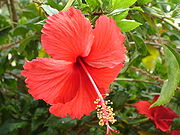Plant Parts (Plant Organs)
In biology, an organ (Latin: organum, "instrument, tool", from Greek όργανον - organon, "organ, instrument, tool") is a tissue that performs a specific function or group of functions. Usually there is a main tissue and sporadic tissues. The main tissue is the one that is unique for the specific organ. For example, main tissue in the heart is the myocardium, while sporadic are the nerves, blood, connective etc.
The flower is the angiosperms reproductive organ. This Hibiscus flower is hermaphroditic, and it contains stamens and pistils.

The flower is the angiosperms reproductive organ. This Hibiscus flower is hermaphroditic, and it contains stamens and pistils.
Strobilus of Equisetum.Organs of plants can be divided into vegetative and reproductive. Vegetative plant organs are root, stem and leaf. The reproductive organs are variable. In angiosperms, they are represented with the flower, seed and fruit. In conifers, the organ that bears the reproductive structures is called a cone. In other divisions of plants, the reproductive organs are called strobili (in Lycopodiophyta) or simply gametophores (in mosses).
The vegetative organs are essential for maintaining the life of a plant (they perform the vital functions, such as photosynthesis), while the reproductive organs are essential in reproduction. But, if there is asexual vegetative reproduction, the vegetative organs are those which create the new generation of plants.





